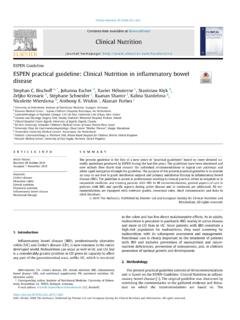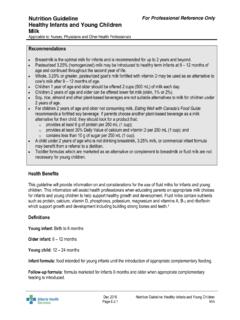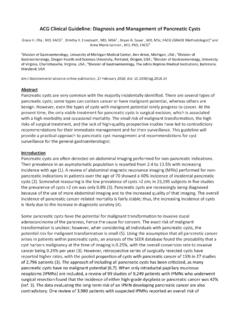Transcription of Best practice guideline for dietitians on the management ...
1 Best practice guideline for dietitians on the management of Parkinson sIn partnership withBDA consensus on the nutritional management of Parkinson sIntroductionPeople living with Parkinson s are particularly susceptible to weight loss and malnutrition. Involuntary movements associated with Parkinson s result in increased energy expenditure, while disease symptoms and medication side effects can limit food intake. They may also choose to follow unconventional nutritional therapies that consequently exacerbate malnutrition. dietitians play a key role in helping patients with Parkinson s to optimise their nutritional status and manage various nutrition -related symptoms and medication side effects.
2 To assume this role, dietitians need to have up-to-date knowledge about the nutritional consequences of Parkinson s, as well as strategies for managing a variety of nutrition -related management at different stages of Parkinson sDiagnosis and early disease Parkinson s can be a challenging diagnosis to make in its early stages. It is a diagnosis based on clinical observation and exclusion of other assessmentThe initial assessment could be facilitated by another healthcare professional as well as a dietitian Parkinson s Nurse, GP or practice nurse. Examples of assessments that could be undertaken are: weight; height; body mass index (BMI); and/or using a validated nutrition screening tool the Malnutrition Universal Screening Tool (MUST).
3 2 Dietary interventionHealthy eatingThere is no specific diet required; however, people newly diagnosed with Parkinson s should be advised to eat a healthy and well-balanced diet. Good nutrition is essential to the wellbeing of this client group. It is imperative to establish and maintain good eating habits throughout the course of the and verbal information should be provided on how to adopt the Healthy Eating guidelines set out by the Food Standards Agency (FSA) and incorporated by the Parkinson s UK booklet Diet and Parkinson maintenanceBeing underweight, something commonly experienced by those living with Parkinson s, as well as being overweight can lead to adverse health effects.
4 In overweight individuals, it is advised that an agreed goal for ideal body weight should be established. This is especially significant in those who have co-morbidities hypertriglyceridaemia, diabetes, CVD the case of weight loss, when other medical causes of weight loss can be safely excluded, NICE has advised that people living with Parkinson s experiencing weight loss should be referred to a Most likely in the early stages of Parkinson s, oral nutrition support where deemed appropriate, will be provided initially before the need for artificial nutrition support ( NG/PEG).
5 However this client group is unique and must be treated as individuals; it is well known that this condition does not affect one person in the same way as the fibre dietConstipation is one of the most common problems experienced by Parkinson s patients. About 60 80% of patients with Parkinson s complain of constipation, which usually appears about 10 to 20 years before motor symptoms become It is thought to be caused by damage to the peripheral or central nervous Other causes of constipation in Parkinson s patients are lack of fibre intake, lack of fluid intake, decreased mobility and as a result of some Parkinson s medications.
6 Dietary advice on how to prevent constipation by following a high fibre/fluid intake is well outlined in the Parkinson s UK booklet Looking after your bladder and bowel. AntioxidantsOnce Parkinson s has been diagnosed, there is no evidence to support that taking supplemental doses of antioxidants slows the progression of the condition or enhances the effects of Parkinson s drugs. For those who are concerned about their intake of antioxidants, they should be reassured that a well-balanced diet will meet their antioxidant needs and that food sources of these nutrients (particularly fruit and vegetables) may be better, safer and less expensive than consuming large quantities of supplements.
7 Providing them with the Parkinson s UK information sheet Antioxidants and Parkinson s (FS67) will help reinforce your advice and Q10It was previously thought that taking supplementary co-enzyme Q10 would delay the progression of Parkinson s. Owing to the lack of scientific evidence, the NICE guideline for Parkinson s disease5 has recommended that co-enzyme Q10 should not be used as a neuroprotective therapy, except in the context of clinical trials. Co-enzyme Q10 can be found in offal, beef, soya oil, oily fish and small amounts in peanuts. More information is available in the Parkinson s UK information sheet Co-enzyme Q10 (FS74).
8 MonitoringDietitians at established Parkinson s centres agree that people newly diagnosed with, or in the early stages of the condition, should be reviewed on an annual basis or at the patients and/or multidisciplinary team s diseaseDietetic assessmentAssessment is similar to the early stages of the condition paying particular attention to: yunintentional weight-loss ydecreased oral intake yswallowing difficulties yincreased frequency of dyskinesias (abnormal involuntary movements) yconstipation yside effects of medication (see table 1) yphysical difficulties impairing eating and drinking and preparing meals ybone health yweight-gain after deep brain stimulator (DBS) insertion yfrequency of on (increased involuntary movements) and off (increased muscle tone) periods yorthostatic hypotension (OH)
9 Characterised by a sudden fall in blood pressure that occurs when a person assumes a standing position3 Table 1: Medication side effects: The following medications are commonly used in the management of Parkinson sName of drugMode of actionSide effectsLevodopa(Madopar, Sinemet)The most effective drug in the treatment of Parkinson s. It is a larger neutral amino acid tyrosine derivative and is absorbed in the small intestine. Once absorbed it crosses the blood-brain barrier where it is converted to dopamine. Prolonged use can result in nausea, vomiting and hypotension.
10 A decarboxylase inhibitor Benserazide, is combined with levodopa to minimise these side agonists (Pergolide, Apomorphine)These are a class of drugs that provide antiparkinsonian effects while avoiding some of the problems associated with side effects of these drugs included nausea, vomiting, postural hypotension and psychiatric problems. They tend to occur with the initiation of treatment and as intolerance develops over several days to inhibitors(Selegiline)This is used in the early stages of Parkinson s to delay the use of levodopa. It provides reduced motor fluctuations and increased on time.









